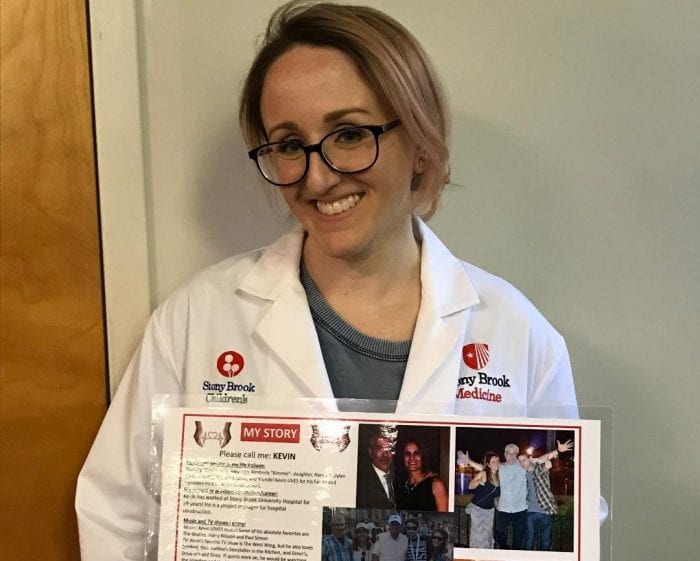SB Hospital Nurses Reach Out to Families to Better Know Their Patients

Patients battling COVID-19 at Stony Brook University Hospital have allies who can see them and their lives outside the context of the current pandemic.
Thanks to a team of nurses at Stony Brook who are calling family members to gather information and putting together pictures the family members are sending, over 89 patients have received the kind of personalized support they might have gotten if their family and friend network were allowed in the hospital during the pandemic.
“You get everything,” said Amanda Groveman, a Stony Brook Medicine Quality Management Practitioner, who has worked at the hospital since 2006 and created a Power Point template for the information. Family members are sending pictures at of them during Christmas, of people playing various sports, of pets, of other family members, and even a wedding picture from the 1930’s.
Once the nurses gather this information, they print out two copies and laminate them. One copy goes in the room, where the patient can also see it, and the other is in the hallway, where the doctor or nurse who is about to walk in can get a broader look at the life of the patient in the bed on the other side of the door.
The effort, called “My Story,” is an extension of a similar initiative at the hospital for patients who have Alzheimer’s Disease and might also have trouble sharing their lives with the health care workers.
The nurses involved in the program include: Chief of Regulatory Affairs Carolyn Santora, Assistant Director of Nursing Susan Robbins, Director of Quality Management Grace Propper, Lisa Reagan, the patient coordinator and Nurse Practitioner April Plank.
“It’s not just a bullet point checklist,” Groveman said. “It’s creating a history of this patient.”
Some patients like to hear a particular type of music. Indeed, one patient routinely listened to so much “Willie Nelson, that was all he wanted to listen to.”
Grovemen said the contact with the family also connects the nurses to that family’s support network, which they now aren’t able to see in eerily empty waiting rooms.
“You speak to these families and then you feel like you do know this person well,” Groveman said. “At a certain point, it’s not just about the patient. It’s about the whole support system. You’re pulling not just for them, but for their whole family.”
The pictures serve as an inspiration for the nurses as well, who get to share their passion for pets or for sports teams.
These connections are especially important, as some patients have been in the ICU for weeks.
Each time a person leaves the hospital, the staff plays the Beatles song, “Here Comes the Sun,” which has also been encouraging to the hospital staff who has been treating them.
When Groveman returns to her family, which includes her husband Matt and their two children, each night, she puts her clothing in the washing machine and takes a shower before she enjoys her own family time.
“As soon as I walk in, they say, ‘No hug yet,’” Groveman said. Her kids have been “really good” about the new nightly pattern.
A by product of her new routine is that Groveman has also been washing her hands and wrists so often that she has developed what her daughter calls “lizard skin.”
She insists on disinfecting everything that comes in the house, which means that she has a collection of cardboard boxes on her porch that wait there until recycling day.
Amid all the public health struggles she and her fellow nurses see every day, she appreciates how Stony Brook has set up a room where nurses can meditate and relax.
Groveman said she’s surprised by the number of people who are coming in who are in their 30’s and 40’s. One of the more challenging elements of caring for patients is, for her, that she sees people who come in who are not in bad shape, but “unfortunately, with this, it can just be all of a sudden someone takes a downturn.”
Groveman had previously worked in pediatrics, where she said she recognized that any treatment for children also benefited the broader family.






